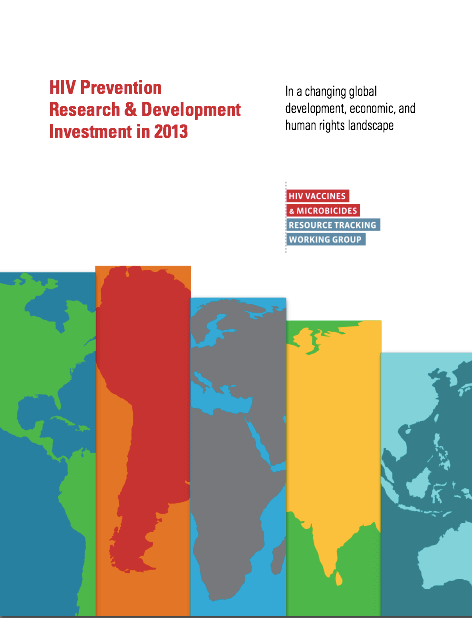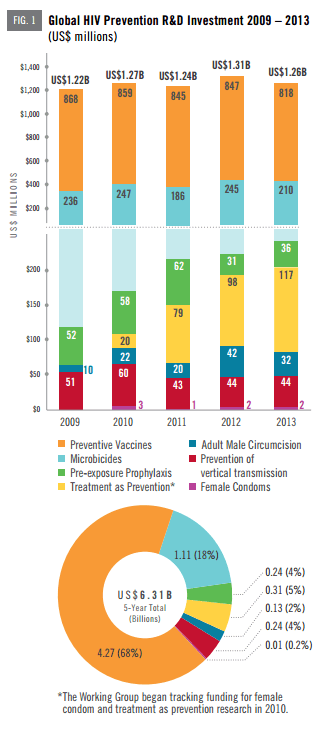In this guest post, Emily Donaldson—program coordinator at AVAC—and Tom Harmon—senior policy analyst at the International AIDS Vaccine Initiative (IAVI)—write about the state of HIV prevention research funding as the first-ever conference devoted solely to HIV prevention research and development (R&D) takes place in Cape Town, South Africa, this week.
Progress toward new tools to prevent HIV infection—including vaccines, microbicides, the use of antiretroviral treatment as HIV prevention, pre-exposure
prophylaxis (PrEP), and a host of other options—is being presented and discussed at the inaugural HIV Research for Prevention Conference (HIVR4P)
in Cape Town this week.
 While much progress has been made over the last few years,
a four percent decline in funding between 2012 and 2013 speaks to the uncertain nature of the global environment in which that research is taking place.
Such cuts hinder the ability of the researchers in Cape Town and across the globe to continue their work and could delay progress toward efficacy trials
and eventual rollout of new prevention options.
While much progress has been made over the last few years,
a four percent decline in funding between 2012 and 2013 speaks to the uncertain nature of the global environment in which that research is taking place.
Such cuts hinder the ability of the researchers in Cape Town and across the globe to continue their work and could delay progress toward efficacy trials
and eventual rollout of new prevention options.
Investment data for almost every technology being discussed in Cape Town can be found in HIV Prevention Research & Development Investment in 2013: In a changing global development, economic, and human rights landscape—the
most recent annual report by the HIV Vaccines and Microbicides Resource Tracking Working Group.
The data show that the US government continued to fund more than 70 percent of HIV prevention R&D efforts in 2013. The combination of recent funding
cuts across all US government budgets and declines in European investment in HIV prevention R&D led to the overall decline in funding from the
previous year. Relying on such a small number of very committed donors is problematic when one or more of those donors is forced to reduce their support.The
report also highlights funding declines in nearly every category of HIV prevention R&D, underscoring an urgent need to sustain and diversify funding
sources through partnerships between governments, philanthropies, and the biopharmaceutical industry.
 The
2013 data provoke a concern that HIV prevention R&D is increasingly becoming a lower priority for public agencies funding international development,
as portfolios and priorities within those agencies shift. Global health and development negotiations such as those around developing successors to
the United Nations’ Millennium Development Goals take place far from the context of most HIV prevention clinical trials, but such international commitment
at the highest levels can keep HIV and AIDS a priority for development agencies that can bolster support for science, technology, and innovation in endemic
countries to end the epidemic.
The
2013 data provoke a concern that HIV prevention R&D is increasingly becoming a lower priority for public agencies funding international development,
as portfolios and priorities within those agencies shift. Global health and development negotiations such as those around developing successors to
the United Nations’ Millennium Development Goals take place far from the context of most HIV prevention clinical trials, but such international commitment
at the highest levels can keep HIV and AIDS a priority for development agencies that can bolster support for science, technology, and innovation in endemic
countries to end the epidemic.
The report also compiles the number of volunteers taking part in HIV prevention R&D trials, which totaled almost 670,000 people in 2013. Most of these
individuals are based in sub-Saharan Africa where the epidemic has its most profound impact and where several large-scale treatment-as-prevention and
voluntary medical male circumcision trials and projects are underway. However, that balance doesn’t cut across all new prevention technologies—80
percent of volunteers in vaccine and PrEP trials reside in the United States and Europe. Ensuring that new HIV prevention options are appropriate and
acceptable means testing them in partnership with those regions and those communities that need them most.
Such communities are represented here at HIVR4P, and we’re excited by the opportunity to see them mingling with the experts working tirelessly to improve
the state of HIV prevention R&D science and in turn hasten an end to the AIDS epidemic. However, they can’t do it without a diverse, committed
investment base. Funding data show signals of vulnerability in support for HIV prevention R&D and support the need for policymakers and advocates
to ensure that the state of the field remains a healthy one.
The HIV Vaccines and Microbicides Resource Tracking Working Group consists of AVAC, IAVI,
and the Joint United Nations Programme on HIV and AIDS. The report and summary materials are available at www.hivresourcetracking.org.

 While
While  The
2013 data provoke a concern that HIV prevention R&D is increasingly becoming a lower priority for public agencies funding international development,
as portfolios and priorities within those agencies shift. Global health and development negotiations such as those around developing successors to
the United Nations’ Millennium Development Goals take place far from the context of most HIV prevention clinical trials, but such international commitment
at the highest levels can keep HIV and AIDS a priority for development agencies that can bolster support for science, technology, and innovation in endemic
countries to end the epidemic.
The
2013 data provoke a concern that HIV prevention R&D is increasingly becoming a lower priority for public agencies funding international development,
as portfolios and priorities within those agencies shift. Global health and development negotiations such as those around developing successors to
the United Nations’ Millennium Development Goals take place far from the context of most HIV prevention clinical trials, but such international commitment
at the highest levels can keep HIV and AIDS a priority for development agencies that can bolster support for science, technology, and innovation in endemic
countries to end the epidemic.